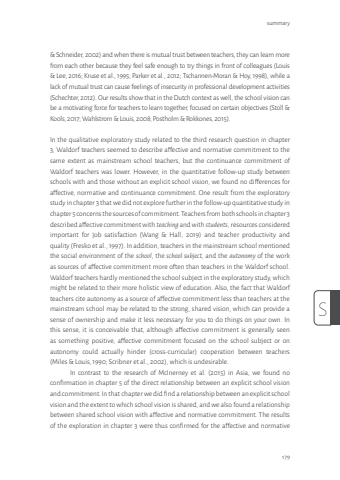Page 181 - Demo
P. 181
summary179S& Schneider, 2002) and when there is mutual trust between teachers, they can learn more from each other because they feel safe enough to try things in front of colleagues (Louis & Lee, 2016; Kruse et al., 1995; Parker et al., 2012; Tschannen-Moran & Hoy, 1998), while a lack of mutual trust can cause feelings of insecurity in professional development activities (Schechter, 2012). Our results show that in the Dutch context as well, the school vision can be a motivating force for teachers to learn together, focused on certain objectives (Stoll & Kools, 2017; Wahlstrom & Louis, 2008; Postholm & Rokkones, 2015).In the qualitative exploratory study related to the third research question in chapter 3, Waldorf teachers seemed to describe affective and normative commitment to the same extent as mainstream school teachers, but the continuance commitment of Waldorf teachers was lower. However, in the quantitative follow-up study between schools with and those without an explicit school vision, we found no differences for affective, normative and continuance commitment. One result from the exploratory study in chapter 3 that we did not explore further in the follow-up quantitative study in chapter 5 concerns the sources of commitment. Teachers from both schools in chapter 3 described affective commitment with teaching and with students, resources considered important for job satisfaction (Wang & Hall, 2019) and teacher productivity and quality (Fresko et al., 1997). In addition, teachers in the mainstream school mentioned the social environment of the school, the school subject, and the autonomy of the work as sources of affective commitment more often than teachers in the Waldorf school. Waldorf teachers hardly mentioned the school subject in the exploratory study, which might be related to their more holistic view of education. Also, the fact that Waldorf teachers cite autonomy as a source of affective commitment less than teachers at the mainstream school may be related to the strong, shared vision, which can provide a sense of ownership and make it less necessary for you to do things on your own. In this sense, it is conceivable that, although affective commitment is generally seen as something positive, affective commitment focused on the school subject or on autonomy could actually hinder (cross-curricular) cooperation between teachers (Miles & Louis, 1990; Scribner et al., 2002), which is undesirable.In contrast to the research of McInerney et al. (2015) in Asia, we found no confirmation in chapter 5 of the direct relationship between an explicit school vision and commitment. In that chapter we did find a relationship between an explicit school vision and the extent to which school vision is shared, and we also found a relationship between shared school vision with affective and normative commitment. The results of the exploration in chapter 3 were thus confirmed for the affective and normative Ester Moraal.indd 179 22-09-2023 16:13


